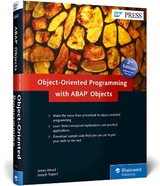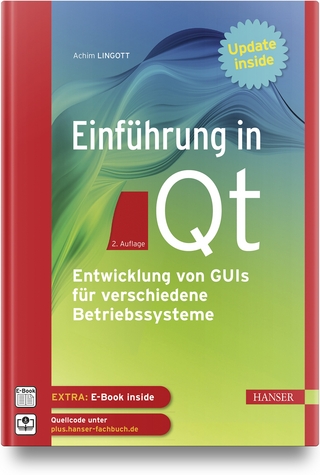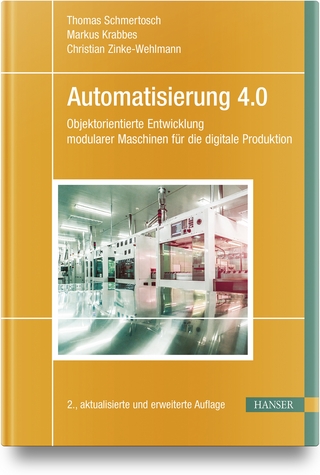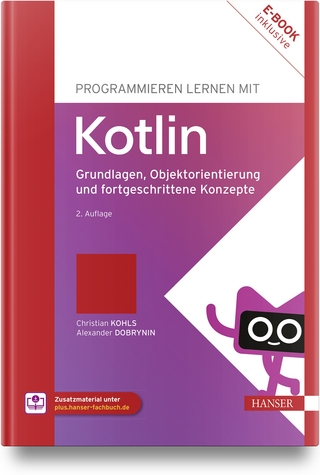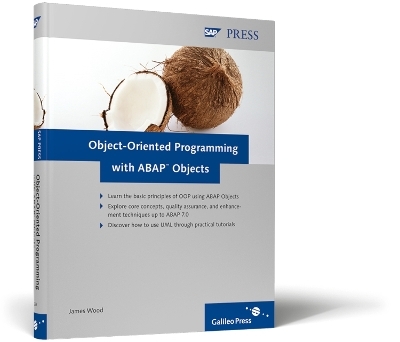
Object-oriented Programming with ABAP Objects
SAP Press (Verlag)
978-1-59229-235-6 (ISBN)
- Titel ist leider vergriffen;
keine Neuauflage - Artikel merken
James Wood is the founder and principal consultant of Bowdark Consulting, Inc., an SAP NetWeaver consulting and training organization. With more than seven years of experience as a software engineer, James specializes in custom development in the areas of ABAP Objects, Java/J2EE, SAP NetWeaver Process Integration, and the SAP NetWeaver Portal.Before starting Bowdark Consulting, Inc. in 2006, James was an SAP NetWeaver consultant for SAP America, Inc. and IBM Corporation where he was involved in multiple SAP implementations. He holds a master's degree in software engineering from Texas Tech University.
Introduction 15
Introduction to Object-Oriented Programming 23
1.1 The Need for a Better Abstraction 23
1.2 Classes and Objects 24
1.3 Establishing Boundaries 27
1.4 Reuse 29
1.5 Object Management 33
1.6 UML Tutorial: Class Diagram Basics 33
1.7 Summary 39
Working with Objects 41
2.1 Syntax Overview 41
2.2 Creating and Using Objects 52
2.3 Building Your First Object-Oriented Program 64
2.4 Getting Started with the Class Builder 71
2.5 Case Study: Working with Regular Expressions 82
2.6 UML Tutorial: Object Diagrams 84
2.7 Summary 86
Encapsulation and Implementation Hiding 89
3.1 Lessons Learned from the Procedural Approach 89
3.2 Data Abstraction with Classes 94
3.3 Defining Component Visibilities 95
3.4 Hiding the Implementation 101
3.5 Designing by Contract 102
3.6 UML Tutorial: Sequence Diagrams 103
3.7 Summary 105
Object Initialization and Cleanup 107
4.1 Creating Objects 107
4.2 Controlling Object Initialization with Constructors 111
4.3 Taking Control of the Instantiation Process 117
4.4 Garbage Collection 121
4.5 Tuning Performance 122
4.6 UML Tutorial: State Machine Diagrams 125
4.7 Summary 126
Inheritance 127
5.1 Generalization and Specialization 128
5.2 Inheriting Components 133
5.3 The Abstract and Final Keywords 140
5.4 Inheritance Versus Composition 145
5.5 Using the Refactoring Assistant 148
5.6 UML Tutorial: Advanced Class Diagrams Part I 150
5.7 Summary 153
Polymorphism 155
6.1 Object Reference Assignments Revisited 155
6.2 Dynamic Method Call Binding 160
6.3 Interfaces 163
6.4 UML Tutorial: Advanced Class Diagrams Part II 180
6.5 Summary 182
Component-Based Design Concepts 183 7.1 Understanding the SAP Component Model 183
7.2 The Package Concept 185
7.3 UML Tutorial: Package Diagrams 197
7.4 Summary 199
Error Handling with Exceptions 201
8.1 Lessons Learned from Prior Approaches 201
8.2 The Class-Based Exception Handling Concept 203
8.3 Dealing with Exceptions 205
8.4 Raising and Forwarding Exceptions 210
8.5 Creating Exception Classes 219
8.6 UML Tutorial: Activity Diagrams 229
8.7 Summary 231
Unit Testing with ABAP Unit 233
9.1 ABAP Unit Overview 234
9.2 Creating Unit Test Classes 237
9.3 Case Study: Creating a Unit Test in ABAP Unit 241
9.4 Executing Unit Tests 244
9.5 Evaluating Unit Test Results 246
9.6 Moving Toward Test-Driven Development 247
9.7 UML Tutorial: Use Case Diagrams 248
9.8 Summary 253
Working with the SAP List Viewer 257
10.1 Overview of the SAP Control Framework 257
10.2 Overview of the ALV Object Model 260
10.3 Getting Started with the Flight Query Report 261
10.4 Event Handling with the ALV Object Model 271
10.5 UML Tutorial: Communication Diagrams 275
10.6 Summary 277
ABAP Object Services 279
11.1 Object-Relational Mapping Concepts 280
11.2 Persistence Service Overview 280
11.3 Building Persistent Classes 286
11.4 Working with Persistent Objects 293
11.5 UML Tutorial: Advanced Sequence Diagrams 298
11.6 Summary 301
Working with XML 303
12.1 XML Overview 303
12.2 XML Processing Concepts 309
12.3 Case Study: Developing a Reading List ADT 311
12.4 Case Study: Building an XML Document 314
12.5 Case Study: Reading an XML Document 320
12.6 UML Tutorial: Advanced Activity Diagrams 325
12.7 Summary 327
Where to Go From Here 329
Debugging Objects 333
A.1 Debugging Objects Using the Classic ABAP Debugger 333
A.2 Debugging Objects Using the New ABAP Debugger 340
The Author 343
| Reihe/Serie | SAP PRESS Englisch |
|---|---|
| Verlagsort | Maryland |
| Sprache | englisch |
| Maße | 175 x 228 mm |
| Themenwelt | Mathematik / Informatik ► Informatik ► Netzwerke |
| Mathematik / Informatik ► Informatik ► Programmiersprachen / -werkzeuge | |
| Informatik ► Software Entwicklung ► Objektorientierung | |
| Informatik ► Weitere Themen ► SAP | |
| ISBN-10 | 1-59229-235-6 / 1592292356 |
| ISBN-13 | 978-1-59229-235-6 / 9781592292356 |
| Zustand | Neuware |
| Haben Sie eine Frage zum Produkt? |
aus dem Bereich
